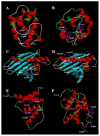Features and Possible Applications of Plant Lipid-Binding and Transfer Proteins
- PMID: 36676809
- PMCID: PMC9866449
- DOI: 10.3390/membranes13010002
Features and Possible Applications of Plant Lipid-Binding and Transfer Proteins
Abstract
In plants, lipid trafficking within and inside the cell is carried out by lipid-binding and transfer proteins. Ligands for these proteins are building and signaling lipid molecules, secondary metabolites with different biological activities due to which they perform diverse functions in plants. Many different classes of such lipid-binding and transfer proteins have been found, but the most common and represented in plants are lipid transfer proteins (LTPs), pathogenesis-related class 10 (PR-10) proteins, acyl-CoA-binding proteins (ACBPs), and puroindolines (PINs). A low degree of amino acid sequence homology but similar spatial structures containing an internal hydrophobic cavity are common features of these classes of proteins. In this review, we summarize the latest known data on the features of these protein classes with particular focus on their ability to bind and transfer lipid ligands. We analyzed the structural features of these proteins, the diversity of their possible ligands, the key amino acids participating in ligand binding, the currently known mechanisms of ligand binding and transferring, as well as prospects for possible application.
Keywords: acyl-CoA-binding protein; lipid binding; lipid ligand; lipid-binding and transfer protein; pathogenesis-related class 10 proteins; puroindoline.
Conflict of interest statement
The authors declare no conflict of interest.
Figures

Similar articles
-
Molecular Insight into Ligand Binding and Transport by the Lentil Lipid Transfer Protein Lc-LTP2: The Role of Basic Amino Acid Residues at Opposite Entrances to the Hydrophobic Cavity.Biomolecules. 2023 Nov 24;13(12):1699. doi: 10.3390/biom13121699. Biomolecules. 2023. PMID: 38136572 Free PMC article.
-
Interactions between plant lipid-binding proteins and their ligands.Prog Lipid Res. 2022 Apr;86:101156. doi: 10.1016/j.plipres.2022.101156. Epub 2022 Jan 20. Prog Lipid Res. 2022. PMID: 35066006 Review.
-
The binding versatility of plant acyl-CoA-binding proteins and their significance in lipid metabolism.Biochim Biophys Acta. 2016 Sep;1861(9 Pt B):1409-1421. doi: 10.1016/j.bbalip.2015.12.018. Epub 2015 Dec 31. Biochim Biophys Acta. 2016. PMID: 26747650 Review.
-
New insights into ligand binding by plant lipid transfer proteins: A case study of the lentil Lc-LTP2.Biochem Biophys Res Commun. 2020 Jul 12;528(1):39-45. doi: 10.1016/j.bbrc.2020.04.139. Epub 2020 May 23. Biochem Biophys Res Commun. 2020. PMID: 32456792
-
Lipid Transfer Proteins As Components of the Plant Innate Immune System: Structure, Functions, and Applications.Acta Naturae. 2016 Apr-Jun;8(2):47-61. Acta Naturae. 2016. PMID: 27437139 Free PMC article.
Cited by
-
Molecular Insight into Ligand Binding and Transport by the Lentil Lipid Transfer Protein Lc-LTP2: The Role of Basic Amino Acid Residues at Opposite Entrances to the Hydrophobic Cavity.Biomolecules. 2023 Nov 24;13(12):1699. doi: 10.3390/biom13121699. Biomolecules. 2023. PMID: 38136572 Free PMC article.
-
Dual functionality of pathogenesis-related proteins: defensive role in plants versus immunosuppressive role in pathogens.Front Plant Sci. 2024 Aug 2;15:1368467. doi: 10.3389/fpls.2024.1368467. eCollection 2024. Front Plant Sci. 2024. PMID: 39157512 Free PMC article.
-
Structural and Immunological Features of PR-10 Allergens: Focusing on the Major Alder Pollen Allergen Aln g 1.Int J Mol Sci. 2024 May 2;25(9):4965. doi: 10.3390/ijms25094965. Int J Mol Sci. 2024. PMID: 38732184 Free PMC article.
-
Plant Defense Peptides: Exploring the Structure-Function Correlation for Potential Applications in Drug Design and Therapeutics.ACS Omega. 2025 Feb 18;10(8):7583-7596. doi: 10.1021/acsomega.4c11339. eCollection 2025 Mar 4. ACS Omega. 2025. PMID: 40060863 Free PMC article. Review.
-
The Long-Distance Transport of Jasmonates in Salt-Treated Pea Plants and Involvement of Lipid Transfer Proteins in the Process.Int J Mol Sci. 2024 Jul 8;25(13):7486. doi: 10.3390/ijms25137486. Int J Mol Sci. 2024. PMID: 39000596 Free PMC article.
References
Publication types
Grants and funding
LinkOut - more resources
Full Text Sources
Research Materials

